15 Best Microscopes For Sale In 2022 Reviews & Buying Guide
Have you ever wanted a microscope, but weren’t sure which one to buy?
Then wonder no more!
In this article, you can read about 15 different models of microscopes for sale. In this article, you can see which microscope is best used for which field od study, and you can read the short reviews on each of them. Also, I will tell you all you need to know when looking for a microscope to buy, like what features to look out for, what convenient traits will make using them more comfortable, and many others.
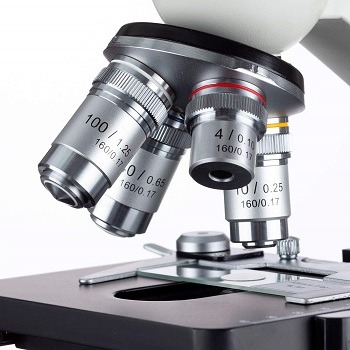
Top 15 Best Microscopes To Buy
Best Light Compound Microscope
Leica DM300 Binocular Microscope
This compound optical microscope has two 10x eyepieces set at a 30° angle, set on a rotatable viewing head. The focus mechanism is dust-proof, and the mechanical stage was built for precise adjustments of the specimen. It also has a stopper mechanism that ensures the safety of both slides and objectives.
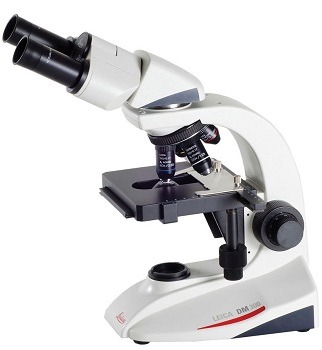
Leica’s four E1 Achromat objectives come on a turret nosepiece, and their magnification power is 4x, 10x, 40x, and 100x. Abbe contrast condenser is labeled to help you achieve the best contrast, and the cool white LED light is very cost-friendly. It is longlasting, consumes less energy, and does not heat up the specimen.
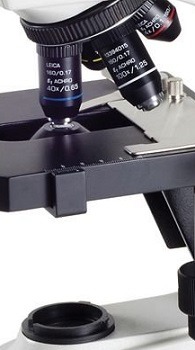
Read more about this kind of microscope in the post about light microscopes. For more information on other models from the brand Leica, or the brand itself, read this post about Leica microscopes.
- cool LED illumination
- adjustable interpupillary distance
- mechanical stage
- objective stopper
- only 1 light setting
- permanent eyepiece pointer
Best Digital USB Microscope
Dino-Lite AM3111 Microscope
This portable digital microscope has 8 built-in LED lights, which can be turned on/off or adjusted by using the software that comes with the device. Its enhanced optics let you view objects clearly even in low-light conditions. The special true-color technology lets you observe the specimen in its natural colors.
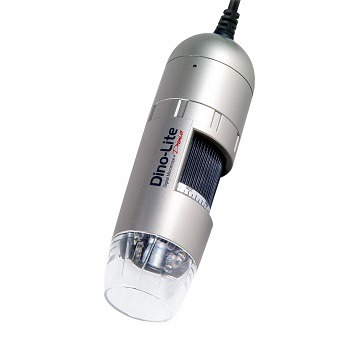
The optical magnification of this device can be adjusted between 10x and 50x, and with the use of digital magnification, this can reach up to 230x. This digital microscope has a resolution of 640 x 480 pixels and a refresh rate of 30fps. It connects to a PC via USB 2.0 cable.
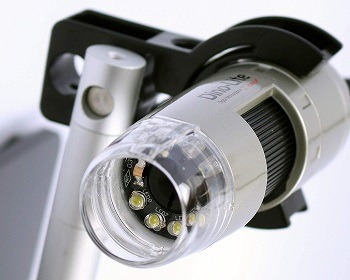
To learn more details about this model, or to take a look at other models of digital microscopes, read this post on digital microscopes. You can also find more information on this device, as well as other microscopes Dino-Lite has to offer, on this post about Dino-Lite microscopes.
- true colors technology
- 8 built-in LEDs
- low-light visibility
- connects via USB 2.0 only
- light adjustment in-software only
Best Professional Optical Microscope
Omax Lab Professional Microscope
This professional binocular microscope can be used in its common version or with the USB digital microscope camera. The LED light provides cool illumination and can be turned on or off with a switch on the base. The fully mechanical stage moves in 3 ways and enables fine adjustments of the sample during observation.
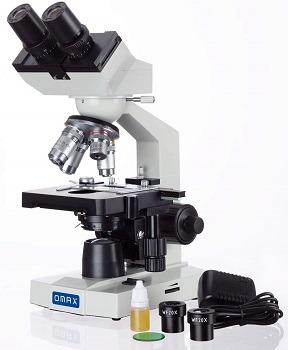
One of the biggest upsides of this device is definitely its magnification power, which ranges from 40x and up to 2000x, which makes it one of the most powerful optical microscopes out there. It is suitable for professional and domestic use.
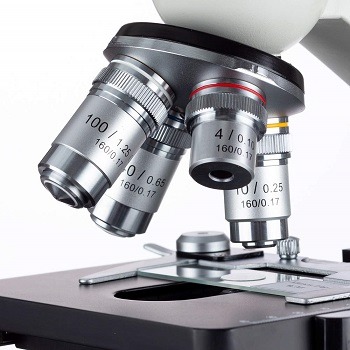
Should you want to read more about this device and other models of the same type, read this post on professional microscopes. For more information about the Omax brand and what they offer, read about Omax microscopes.
Best Handheld Microscope With Camera
Celestron Handheld Digital Microscope Pro
The Celestron microscope comes with a metal stand whose height you can easily adjust. The device itself weighs 1.43 pounds and LED lights with adjustable intensity, with the adjustment dial located on the 4-foot long USB 2.0 cable. The magnification power of this microscope varies from 20x to 200x.
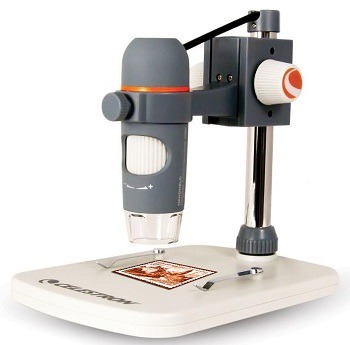
You can use the 5.0 MP resolution camera to take pictures or videos, but the final resolution will depend on the screen you are using it with. This digital microscope comes with its software installation CD, which enables you to take measurements and edit videos.
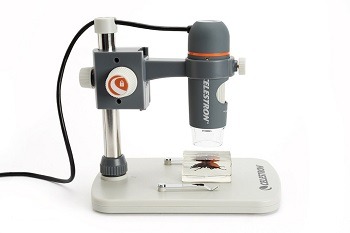
In case you are interested in knowing more about this microscope, or similar models, you can read this post on handheld microscopes. For more information about the Celestron brand, and learning what they else they have, read this post on Celestron microscopes.
- adjustable illumination
- software included
- plastic casing
- low-quality camera
- software not widely supported
Best Binocular Compound Microscope
Labomed LB-240 Binocular Compound Microscope
This versatile binocular microscope can be used in medical establishments and institutes, laboratories, universities, etc. The precise and advanced build of this device, as well as the anti-fungal coating, make it durable and safe to use regardless of the conditions.
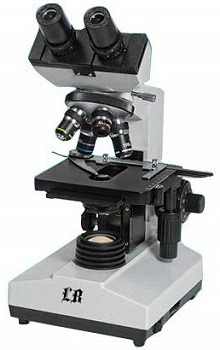
This microscope has a forward-facing nosepiece with 4 objectives, and a magnification range from 40x to 1000x. It has a brightfield LED light with a rheostat to adjust the intensity and potentially preserve specimens, and the Abbe condenser with a diaphragm ensures its maximum efficiency. The coaxial fine and coarse focus knobs are located on both sides of the 2-layered mechanical stage, for easy access.
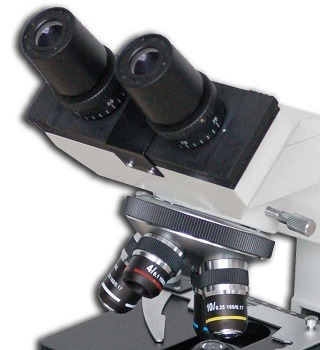
If you want to know more about this microscope, as well as view some other similar ones, read this post on binocular microscopes. For more information on the Labomed brand, read this post about Labomed microscopes.
- adjustability and comfort
- 2-layer mechanical stage
- color correction
- anti-fungal coating
- adjustable LED illumination
- expensive
- forward-facing nosepiece
- aluminum body
Best Dissecting Microscope
AmScope SE306-PZ Dissecting Microscope
The AmScope dissecting microscope has three magnification settings, and they range up to 80x, which is more than most microscopes of this type. It features dual light sources, the 10W incident halogen light, and the bottom transmitted light for the transparent specimens.
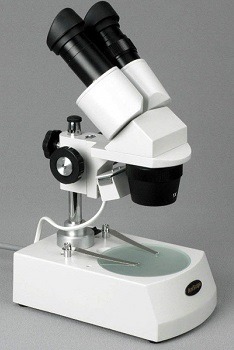
The AmScope features a fully-coated glass optical system and comfortably inclined eyepieces on the viewing head. The two stages can be used for viewing different specimens, securing them with clips. This ensures they stay in place during observation.
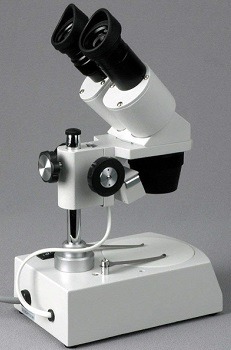
For more information on this microscope and similar models, read this post about dissecting microscopes. In case this made you interested in AmScope products, you can read more about AmScope microscopes.
- 2 stage plates
- transmitted and incident light source
- good quality optical glass lenses
- 1 objective
- small working area
Best Basic Beginner Microscope
National Geographic Student Microscope
This simple binocular microscope is user-friendly and easy to use. The sturdy metal construction ensures durability, and its simple design with a minimum amount of mobile parts ensure less damage over time. This device comes with some additional accessories that will help you learn.
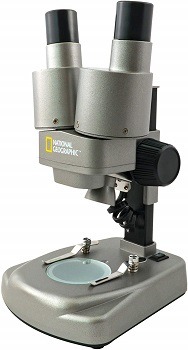
The dual light system will help by illuminating both small and large specimens you wish to observe. The lower light is recommended to use with slides, whereas the upper light is meant to illuminate larger objects you are looking at. This device has 2 magnification settings, 20x and 50x.
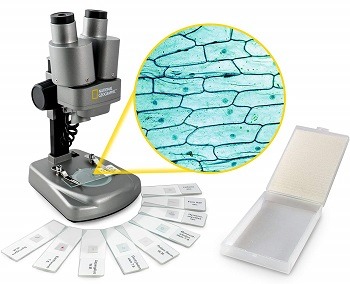
In case you are interested in more microscopes that beginners can use at home, read this post about beginner home microscopes. For more about the Nation Geographic brand and devices, read about National Geographic microscopes.
- easy to use
- kid-friendly
- 2 LED light sources
- accessories
- only 2 magnification settings
- low maximum magnification
- only 1 objective
Best Stereo Microscope
Swift S14- 20x Dissecting Binocular Stereo Microscope
This microscope is different than most microscope models, in that is does not have a regular stage and stand, but rather comes on a stand with a swiveling arm, adjustable in height. This lets you position the viewing head in a hovering positing over the object you are observing, and it allows for more working room.
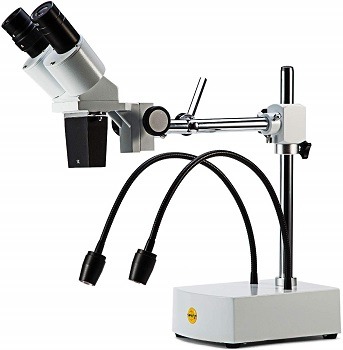
You can adjust the eyepieces to your eye height, and under it, you have enough free space to maneuver the object for dissection and micro-operation, as well as other actions. The dual goose-necked LED lights have long bendable necks and can be adjusted to precisely and closely illuminate your object from any desired angle.
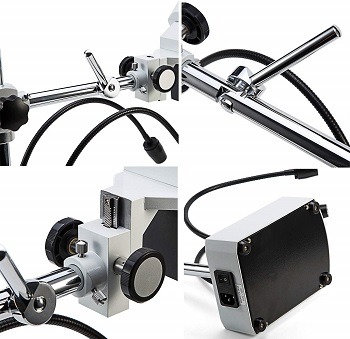
Should you want to look through more microscopes of this type and similar, read this post about stereo microscopes. For more products by the Swift brand, read this post about Swift microscopes.
- 2 goose-necked LED lights
- metal build
- adjustable swiveling arm
- large working area
- low magnification
- one objective
- clumsy focus
Best Science Microscope For Kids
Omano Juniorscope Microscope
This child-friendly microscope has 3 magnification settings, and the maximum magnification it can achieve is up to 400x. The chunky focus knob might seem a little clumsy, but its size helps kids learn how to use the focus feature.
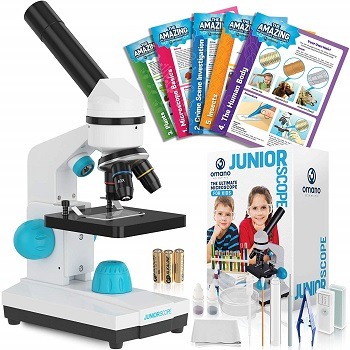
This microscope is portable and light, and battery-operated. The dual illumination helps you view and explore different types of specimens, as will the numerous accessories that come with the device.
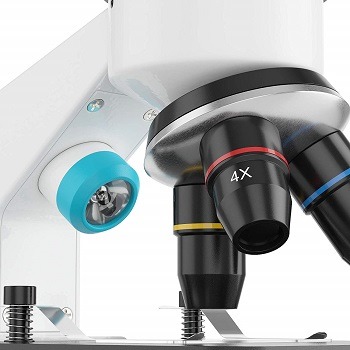
For any additional details on this microscope and similar models, read this post on microscopes for kids. You can also find more details about this microscope and the brand by reading about Omano microscopes.
- 400x magnification
- battery operated
- light and portable
- dual illumination
- 3 objectives
- chunky focus knob
- monocular head
Best Cheap Portable Microscope
Plugable USB Digital Microscope
This portable little microscope comes with a flexible stand you can set it on when you don’t feel like holding it in your hand. With this Plugable handheld microscope, you can achieve magnification levels that range from 40x to 250x. However, the image clarity depends on the screen you pair it with.
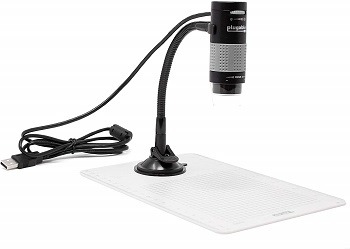
As it is a digital microscope, it can be connected to both PC and phones. It is compatible with most operating systems. The device comes with 4 built-in LED lights, and a pad marked with rulers and a grid, so you can use it as a measuring microscope as well.
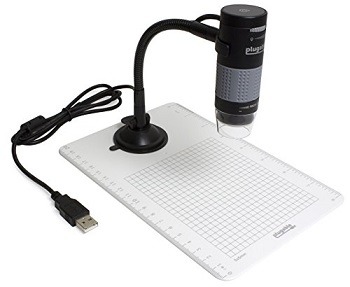
You can read the full review on this device, and more about other types of inexpensive microscopes, in this post about cheap microscopes. For more details about the Plugable brand and their offer, you can read this post about Plugable microscopes.
- portable
- digital
- measurement grid
- flexible stand
- low resolution
- plastic
Best Microscope For Students
Maxlapter Monocular Microscope
Maxlapter microscope has a monocular viewing head and 3 objectives, which means it has only three magnification settings. However, the highest magnification is 2000x, which makes it a good and powerful microscope for studying samples and learning about nature.
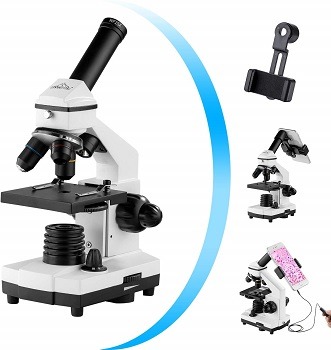
The coarse and fine focus knobs will allow for fine adjustments, and dual illumination will enable you to light up more transparent objects on the slides from below, as well as more solid specimens from above. This device also comes with some accessories, like a phone adapter and a carry bag.
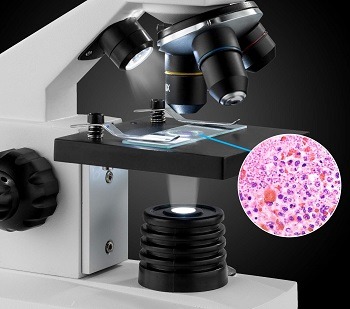
For more details about this microscope, its full review, and information on other types and models of microscopes for students, read this post about student microscopes.
- high magnification power
- separate coarse and fine focus
- dual illumination
- 3 magnification settings
- monocular viewing head
Best WiFi Digital Microscope
Skybasic Handheld Microscope
This handheld microscope comes with a stable metal + plastic stand, which you can use to rest or stabilize the device as necessary. It offers you an unusually wide range of magnification that starts at 50x, with the highest magnification power of up to 1000x zoom. The LED light intensity can be adjusted by rotating the adjustment wheel on the device.
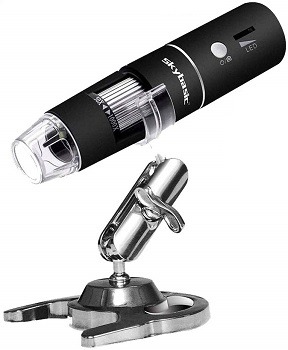
This device uses a 2MP HD sensor, which enables you to take pictures by just pressing the button on the device. The image resolution is up to 1920 x 1080 pixels. The user-friendly software is compatible with Windows and Mac, as well as Android and iOS devices. This microscope recharges via USB cable and connects wirelessly to phones and tablets.
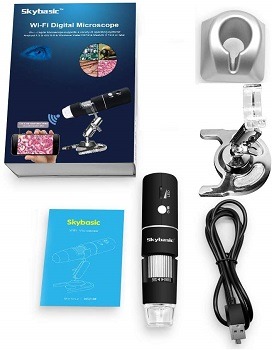
If you want to read more information about this model, or similar devices that connect wirelessly to computers, tablets, and phones, read this on Bluetooth & WiFi microscopes.
- good resolution
- 1000x magnification
- handheld
- portable
- adjustable illumination
- plastic
- needs the USB cable to recharge
Best Biological Microscope
Thames & Kosmos Biology Scope
This microscope has a monocular viewing head, which means there is only one eyepiece you can look through. On the nosepiece, there are 3 objective lenses, which means you can alternate between 3 different magnification settings: 40x, 100x, and 400x. While that is not much, it is sufficient to observe some types of plant cells.

The dual light system allows you to illuminate specimens from below (for slides and transparent or liquid samples), or from above (for solid and opaque samples and surface observation). This device comes with additional accessories and a manual guide, which will help you explore and observe.
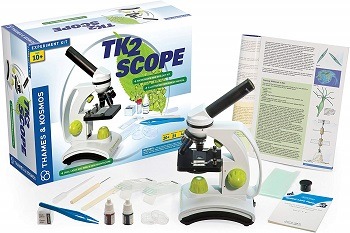
For more information on this microscope or more other microscopes for biological research, feel free to read this post about biological microscopes.
- dual LED light
- accessories
- metal build
- low magnification
- monocular
- only 1 eyepiece type
- plastic knobs
Best Powerful Laboratory Microscope
Radical Cordless Microscope
The radical microscope has a sturdy construction, made from high-quality metal. It also works without external power, which means it can be recharged and operate cordless, out in the field. You could take this device with you and perform on-the-spot research.
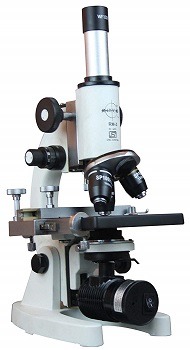
This lab microscope has 6 magnification settings, the highest one reaching 2500x magnification power. That makes it one of the most powerful optical microscopes available for purchase. Two illumination types let you choose between natural daily light and LED illumination.
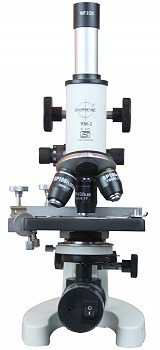
If you are interested in this kind of microscope, feel free to read more about this model, or other kinds of microscopes made for laboratory use, in this post about laboratory microscopes.
- durable construction
- dual illumination
- 2500x magnification
- mechanical stage
- illumination intensity not adjustable
- monocular
Best Inverted Microscope
Motic AE2000 Inverted Microscope
Motic inverted microscope has a 360°rotatable viewing head, with binocular eyepieces set at a 45°angle, which means it is comfortable to use. This device has an interchangeable illumination system, which lets you easily switch from halogen to LED light. As for the halogen light, you can control its intensity.
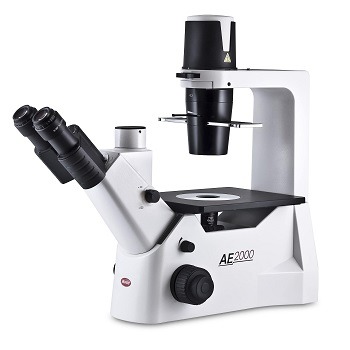
The plan achromatic phase objectives, as well as plan achromatic objectives, offer you a clear image of cells and other specimens, which you put on top of the stage, whereas the objectives are located under it. Another special function this microscope has is the automatic function that turns the device on or off to conserve power.
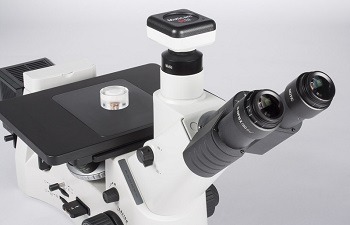
Should you want to see more about this microscope, or other similar models, please read this post about inverted microscopes.
- interchangeable light
- auto on/off
- rotatable head
- binocular eyepieces
- low magnification
- objectives are harder to switch
What To Look Out For When Buying A Microscope?
The Eyepiece Count
Every tabletop microscope has a viewing head on the microscope stand, and it can be monocular (1 eyepiece), binocular (2 eyepieces), or trinocular (3 eyepieces, or 2 eyepieces +1 tube). Binocular viewing heads are more comfortable than monocular ones, because you can view through one eyepiece tube with each eye, making less strain on your neck and eyes during observation.
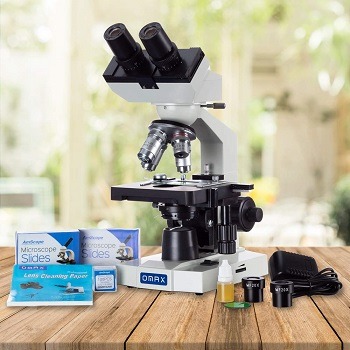
The Viewing Head
Besides the number of eyepieces, the microscopes with a more advanced design will offer you additional features in the viewing head. For instance, the swiveling (horizontally rotating) head means easier sharing in the classroom or laboratory, and the adjustable interpupillary distance and diopter offer you to customize and adjust the microscope to your optimal observing experience.
The Microscope Lens Type And Stage
Some other microscope features you need to look out for are the stage type and microscope lens. A mechanical stage will enable you to precisely adjust and move the specimen during observation, and better ones come in layers. The more objectives you have on the microscope nosepiece, the more magnification setting you have. Don’t forget that their magnification multiplies by the eyepiece magnification. That lets you make combinations and achieve the magnification power you want.
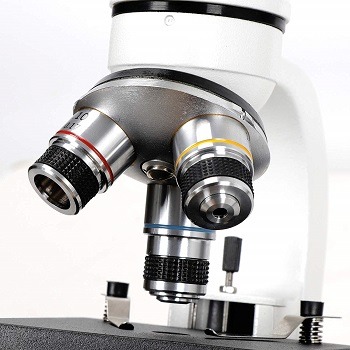
Microscope Illumination Types
A good and cost-efficient illumination choice is certainly the LED bulb type. LEDs consume less power and last much longer than regular halogen bulbs, which means you will not need to replace them often. Some microscopes have a rheostat, which lets you regulate the intensity of light that the bulb emanates, some have a microscope ring light, and some even have 2 light sources. Those will usually have 1 bulb above and 1 under the stage, for observing either translucent specimens on slides or solid objects and their surface.
Microscope Accessories
Many microscopes come with basic equipment, like dust covers and spare slides, but some even include color filters or wrenches for tightening knobs. Microscope cameras can be mounted on the viewing head, and in that case the trinocular viewing heads come in handy. That is because you can continue using the binocular eyepieces while the camera is mounted on the vertical tube, which lets you take pictures or record videos while working.
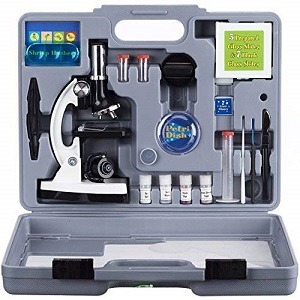
Microscope Prices And Where To Buy Them
All models reviewed here are available on Amazon (amazon.com), which is convenient because you can look up other reviews and compare prices between different models. The price depends on the type of microscope and how advanced its design is, considering what features it includes. Small, handheld microscopes (like Celestron and Dino-Lite) usually offer low magnification but are portable, and cost mostly under 100 dollars. Professional microscopes (like Labomed and Omax) that meet the medical laboratory standard, especially including some extra features and equipment, can cost over 2,000 dollars.
Benefits Of Owning A Microscope
Helps You Discover The Micro-World
Having a microscope as one of your researching tools can greatly improve your work and results while observing the micro world. There are small pocket-size microscopes you can carry along on your travels and field research, and the tabletop ones will ensure you have good results in the lab, school, or home.
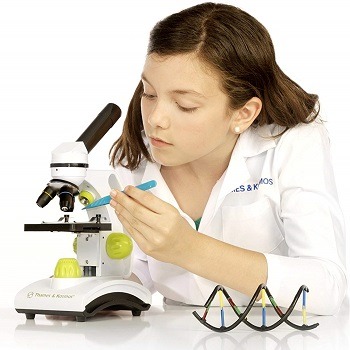
Has Many Practical Uses For Work And Hobby
The smaller handheld microscopes with lower magnification can be used to examine products, jewelry or collector’s items. On the other hand, the big microscopes with high magnification power can be used to examine micro-organisms, cells, tissue, or even molecules and crystalline structures.
Conclusion: Which Microscope To Buy?
Depending on the purpose, you can look through the categories above and choose the best microscope for sale based on what you need it for. All the models reviewed here are fitted into categories for which use they are most recommended. All models are available for purchase online, on amazon.com, and within their wide price range, you can surely find one that suits your needs and your budget.
For more information about different types of microscopes, you can read my post about digital microscopes, or the one about light microscopes. They both cover a variety of models within that type of microscope. If you are looking for a microscope for your child, you might also want to read about microscopes for kids.
